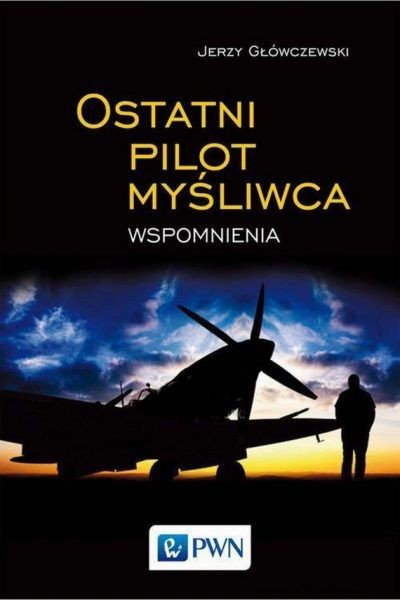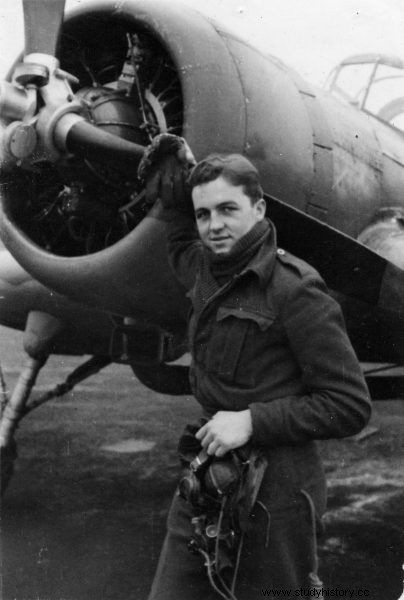On the first day of 1945, the last great offensive of German aviation on the Western Front was launched. A Polish base near Ghent was also attacked. There were half as many Poles as the attackers and most suffered from a hangover. The result was a doomed ... The remains of German machines were collected from all over the area.
From December 16, 1944, the German offensive in the Ardennes continued. Initially, it developed as the attackers wanted, at least as long as they were shielded from above by fog and low-hanging clouds. The streak did not last long, however. Allied defense was firm, and as the weather improved, British and American air forces could take action.
The German staff officers came up with a fairly simple idea. They rightly stated that if the Allies ran out of equipment, the Luftwaffe could regain air superiority. This would support the German counter-offensive in the West and slow the enemy's progress. The command therefore approved a plan for a sudden and massive attack. Almost all of its forces were to hit recognized Allied front-line airfields in order to destroy as many planes as possible still on the ground.
Hermann will meet Varus at 9.20
The attack plan was codenamed "Bodenplatte". On the eve of the operation, the Luftwaffe fighter units received ciphertexts with the date and time of the attack:"Varus 1.1.45" and "Hermann 9.20". The codes alluded to the destruction of Roman legions by the Germanic tribes in the Teutoburg Forest in 9 AD. It was probably treated like a fortune telling.
The news of the New Year's attack did not please the German pilots. Since they were supposed to take off quite early in the morning, they were forbidden to celebrate New Year's Eve. The consumption of alcohol in particular was unacceptable. As a result, many of them never had a schnapps again…

On January 1, 1945, the Germans wanted to surprise the Allies celebrating the New Year. In the overview picture the Focke-Wulf Fw 190.
Meanwhile, no restrictions were introduced on the other side of the front. After all, it was known that the war was nearing a victorious end, and the inhabitants of the liberated territories were very friendly. Celebrations were allowed to go wild. This was the case, for example, with some Polish airmen stationed at the Sint-Denijs-Westrem airport near Ghent.
There were airmen from the 131st Fighter Wing, from the 302th Poznański, 308th Krakow and 317th Wileński squadrons at the base. They were basically planning to celebrate the New Year after they moved to Grimbergen Airport near Brussels. Even part of the staff has already been sent there. Nevertheless, it was eventually allowed to party outside Ghent as well.

The memoirs of Jerzy Główczewski under the title "The Last Fighter Pilot" were published by PWN.
An unpleasant surprise awaited those pilots who greeted the new year with commitment. We slept maybe two hours when the duty officer, pounding on something and screaming at the top of our throat, woke us up from a deep sleep - Sergeant Jerzy Główczewski, a pilot of the Krakow squadron, recalled his premature wake up. It turned out that the 308th and 317th squadrons should start in fifteen minutes. Poles were sent to bomb German crossings. Glowczewski was helped by a mechanic:
- Gosh, you smell like a distillery. Wait a minute ... - [the mechanic] jumped off the wing, grabbed the oxygen cylinder and climbed back, pushing the end of the rubber tube into my mouth.
- Breathe, he screamed as he unscrewed the valve.
The chills have stopped. Eyesight sharpened. A few more minutes and we were in the air. Fairy-tale weather, sun above, snow below, and in the middle of us twelve, cursing for what the world stands for. Nobody in the air, nobody on the ground, silence on the radio, the whole world is probably sleeping off the last night.

"The last pilot" - Jerzy Główczewski next to his plane.
The Germans are coming
Główczewski was wrong when he thought that the whole world was still asleep. At the same time, when Polish units were dropping their bombs on designated targets practically undisturbed, about 800 Luftwaffe planes were heading towards the Allied airports. They came when the Poles were already heading towards the base, thinking about the possibility of sleeping off the night party. This is how the Krakow sergeant described the whole situation:
This sleepy silence was disturbed by a calm voice in my headphones. Someone called our two squadrons with a code (...) "A group of about sixty enemy fighters crossed the front-line mowing flight, heading for Brussels, take a course of 210 degrees, in ten minutes you will meet . Over ”(...) there was no more peace on the radio, every now and then they reported about some groups of Germans flying in different directions.
There was more and more information in the headphones about new enemy formations. Soon the Poles found out that their own base had also been attacked. There were over forty German Focke-Wulf Fw 190s above it. They systematically destroyed planes, cars and buildings standing on the ground. Eventually, the fuel composition was also set on fire. The entire neighborhood was engulfed in thick, black smoke.

Burning Allied planes destroyed on the ground during the German attack.
The ground personnel was hiding in the ditches and watching the attacking Germans helplessly. It seemed that nothing would prevent the attackers from destroying the airport. It was unfortunate that almost all anti-aircraft artillery had already been transferred to the airport in Grimbergen. After all, the entire Polish Wing moved there…
Kozak Tatarzyna caught and Tatarzyn ... got support
However, a few minutes after the start of the raid, the situation changed to the disadvantage of the Germans. Polish planes began to return to Sint-Denijs-Westrem. They were running out of gas, but they still had ammunition and a sincere desire to show the Germans who was in charge.
The first to attack was Lieutenant Wacław Chojecki. He shot one of the attackers with accuracy. The German crashed his wing against a tree, then on the roof of a small building at the airport, and finally on the American heavy 4-engine B-17 bomber standing on the ground. Unfortunately, it was an expensive victory.

“Spare planes and barrels of gasoline were on fire. Against this background, green and silver machines flashed, black crosses were clearly visible. " recalls Jerzy Główczewski.
The Pole was immediately attacked by four other Focke-Wulfs and soon his Spitfire exploded. However, more Polish fighters appeared over the airport and joined the fight with the attackers. Główczewski reported:
Black smoke obscured the entire airport. Spare planes and barrels of gasoline were on fire. Against this background, green and silver machines flashed, and black crosses were clearly visible. There were over forty of them. (…)
An unusual "cauldron" was created, and the attractiveness of the show (as we were told later) was increased by the fact that it was held right next to above the ground. It was probably one of the last classic fighter battles, using all the pilots' acrobatic skills and showing their lightning-fast reflexes.

Jerzy Główczewski in the cabin of his Spitfire.
The Krakow aviator was not only watching. He himself caught up with one of the attackers. This is how he described it in the book The Last Fighter Pilot. Memories ":
I pulled the trigger:pieces from his machine almost splashed in my eyes. The plane started to smoke from the left side of the engine and curled into a tight right turn. (...) [German] smoked more and more, (...) [and another] my series reached the target: flash and the machine shot vertically up . I saw him crucified against the clear blue sky, a second blast and he fell down.
Sergeant Główczewski also barely escaped a similar fate himself. In addition, at some point the engine in his Spitfire just ... stopped. He ran out of fuel! Fortunately, the fight was over. The Poles shot down half of the attacking German planes, and the rest hurriedly escaped. Those who still had some gasoline in their tanks chased them. Others landed on leftover fuel at the airport or (with the landing gear retracted) in the surrounding fields.
Trophies - living, dead and pieces of machines
The attack on the Polish airport caused significant damage. The Germans managed to shoot down two Spitfires in the air and destroy seventeen more. A dozen other Allied machines on the ground were also unusable. Three more Polish fighters were damaged during a belly landing.

The memoirs of Jerzy Główczewski under the title "The Last Fighter Pilot" were published by PWN.
Fortunately, human casualties were few. Four ground personnel were killed; eighteen were injured. Two pilots were killed in the air combat. Apart from Lieutenant Wacław Chojnacki from the 308th Squadron, who was the first to join the fight, Lieutenant Tadeusz Niepodległości from 317 lost his life.
The airmen from the 302nd Squadron did not take part in the fight. They did not manage to return on time and did not meet the enemy on their route. Eventually, due to lack of fuel, they had to land at another airport. Meanwhile, Poles from 308th and 317th squadrons reported as many as 21 air victories after the clash. The RAF officially listed 18.5 of them for sure, 1 as probable and 5 as damage. One of the confirmed killings was the success of Główczyński. He shared them with anti-aircraft artillery. Traces of her bullets were found on the plane he had knocked down.
The pilots, forced to land somewhere in the area after the fight, returned to base all day long. Some brought with them fragments of destroyed German machines . Everyone on the scene was greeted by the wingless Focke-Wulf wreck, with the cockpit open, in which the pilot was still strapped down, but without a head. A peculiar "trophy" was shown by Lieutenant Tadeusz Szlenkier. He knocked down one Focke-Wulf, but for lack of fuel he had to land on some meadow. A moment later a German fighter sat down next to him. The pilot that jumped out of it surrendered to the Pole.

During the Battle of Ghent, Polish pilots thoroughly patched the skin of the Germans. They certainly shot down 18.5 Luftwaffe planes, 1 probable, and damaged 5 more.
The New Year's Battle of the Polish airport near Ghent was the last major air battle fought by Poles during World War II. It is also the last battle in which Polish pilots achieved victories while flying Spitfires.
How did the Germans do? In a way, the attack paid off. They managed to destroy 465 Allied planes that day, most of them on the ground. However, the cost was disproportionately high:they themselves lost 304 machines and 238 pilots, including 29 aircraft and 24 airmen over the Polish base. We sacrificed our last strength summed up the battle as Luftwaffe General Adolf Galland. The irony of fate was the fact that as many as 84 black cross planes were destroyed by their own anti-aircraft artillery that nobody informed about the action.
Operation Bodenplatte did not save the offensive in the Ardennes, which the Germans ended two weeks later. It also did not detain the Allies. At the beginning of spring, they crossed the Rhine and entered the territory of the Third Reich. However, the Cheruski commander Hermann in the Teutoburg Forest did better.
Buy the book at a discount from the publisher's site

